
In today’s world, your company’s website is your digital face to the masses and is the best way to learn about your business and its products and services. As per website development services, providers having a website is a great way to get in touch with customers by offering them information regarding contact details, locations, and other essential details related to the company.
There are millions of websites on the internet, but have you ever wondered if informing customers, clients, partners, and other related parties about the existence of a website is enough? What about Google and its crawlers, which crawling and indexing webpages?
Google, just like any other Popular search engine, crawls the internet. Its crawlers often look for website information, including content, images, etc. For Google to see more of your website via its crawlers, you need to do several things, one of them is to create Sitemap.
Table of Contents
ToggleWhat is a Sitemap?
Sitemap is a collection of lists that define your website’s hierarchical structure, which usually includes a list of links or URLs of each page on your site. It helps users and search engines easily find what they are looking for on your website.
Types of Sitemaps
Usually, two types of sitemaps can be created, such as XML Sitemap and HTML Sitemap, but there is another that we should know:
XML Sitemap
XML sitemaps are codes that allow you to present your website’s pages to search engine crawlers most efficiently. This helps ensure that all the pages on your site are easily discoverable by search engines, which further helps to stay organized and keep track of the pages that have been added or removed from your site. XML sitemaps are ideal for sites with many links to navigate, such as Amazon, Flipkart, Myntra, and many more, with hundreds and thousands of pages that users can enter through. Using this type of sitemap, you can make sure all of these pages are crawled by search engines so that they can show up in SERPs.
HTML sitemap
HTML Sitemaps help users navigate websites by providing a list of web pages available to view, which contain essential sources of information. This is an effective way to help you improve your site’s user experience, as it is easier for users to find what they are looking for on your website, such as making a purchase or subscribing to an email. It also provides an additional signal to search engines to give higher rankings to sites that include reliable sitemaps.
Visual sitemaps
A visual sitemap visually shows a website’s structure and makes it easy for everyone to understand it. The visual Sitemap helps you to plan, discuss and review information architecture, as well as identify potential problems early in the project. Unlike a traditional sitemap, which outlines its content as text and links, a visual sitemap uses pictures or symbols to represent each web page. This allows you to outline what your pages will look like before you even begin building them. It also allows for better organization when creating engaging website content or managing your site. It is often used to assist webmasters with organizing the content on their websites. It also eliminates unnecessary pages and can be implemented even in collaborative environments.
How can Sitemap help?
- Overview of website’s structure: Sitemap can provide an overview of your website’s structure in a way that makes it easier to understand. Using a sitemap will help your users navigate quickly and efficiently through the site by providing links to frequently visited pages.
- Identifying which pages are being crawled: Sitemap is a helpful tool for website owners because it shows which pages on your site are crawled by Google and other search engines. This helps you understand which pages are essential to your site and which might need more attention.
- The frequency of pages being crawled: With Sitemap, you can know how frequently the pages are being crawled by search engines, with detailed information about the page URLs and content that Google’s been able to crawl. You can also use it to inform Google of new or updated sitemaps.
- Pages that are not being indexed: By using Sitemaps, you can identify pages that are not being indexed by the search engines and remove them from the sitemap.
- Determine error pages: With Sitemap, you can determine which pages have errors that need fixing. It also monitors your web pages’ evolution, and it would be best to have a sitemap to keep your website as up-to-date and error-free as possible.
Sitemap Generator Tools or Plugin
1. My Sitemap Generator
Best tool for web crawling with Freetired plans and pricing. It scales with your website size and you may upgrade as you scale your business.
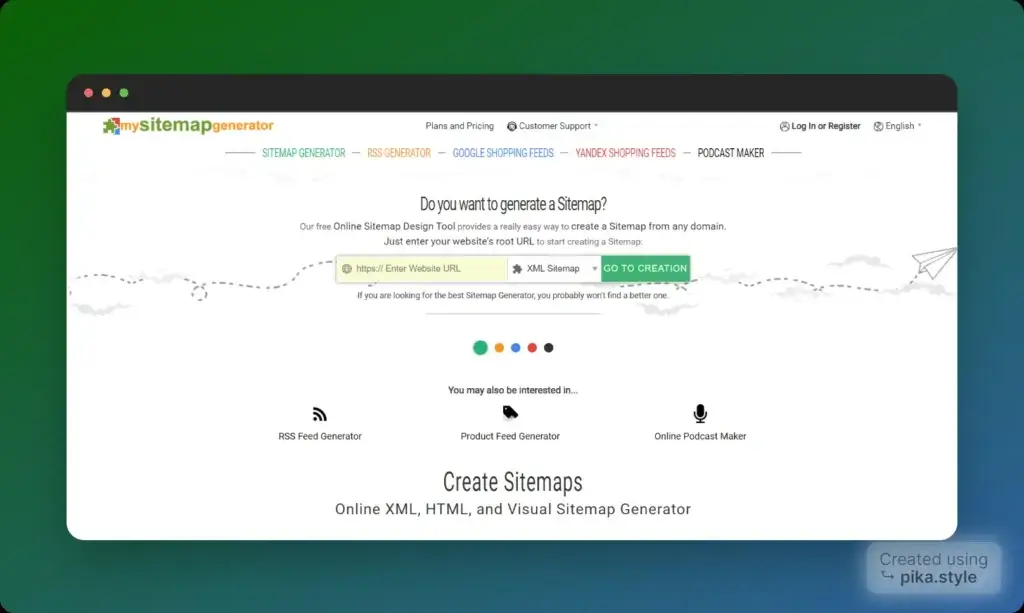
- Imporve Search Results: Drive indexing coverage and improve search result visibility with SEO-optimized sitemaps. Mysitemapgenerator.com ensures website’s content is effectively crawled and indexed by major search engines.
- Scale as you grow: This sitemap generator tool provides solutions for websites of all sizes, from small blogs to large eCommerce stores.
- User friendly interface: No technical background required; our intuitive interface makes sitemap creation. Easily navigate through the tool and generate sitemaps with just a few clicks. Just copy your website url and it would scrape all the urls for you.
- Flexible output format: Mysitemapgenerator.com has both xml and csv export options so you can export the page/products in your desired format without any hussle.
- High in Compatibility and Reliability: Compatible with any platform or CMS, ensuring seamless integration with your existing setup. Trust in our reliable service that minimizes resource consumption and maximizes efficiency.
- Affordable Pricing: Free upto 500 urls crawled. $2.5 one time access for 1million urls, $4 per month for Unlimited Crawling of urls.
2. Yoast SEO Sitemap Plugin
Yoast SEO’s sitemap generator is a free tool with an easy way to add an XML sitemap to your website. Some of its features are:
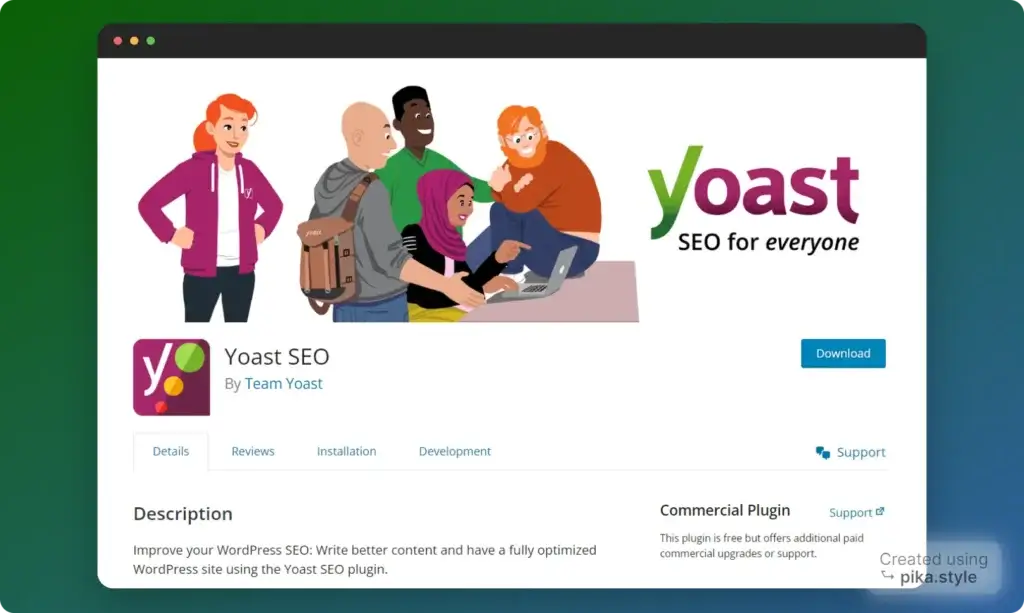
- Search Engine Compatibility: Compatible with Google, Bing, and other major search engines, enhancing the discoverability of pages on your site.
- Intuitive Interface: The user-friendly interface allows easy addition of relevant pages to the sitemaps, while excluding those that should not be included.
- Automated Handling: Yoast SEO handles pagination and 404 redirects on your website automatically.
- Page Size Limit: The Yoast Sitemap comes with a page size limit of 1,000 connected URLs, providing the flexibility to add thousands of pages to the sitemaps.
- Priority and Frequency Settings: Users can set priority and update frequency for individual pages, guiding search engines on the importance and frequency of content updates.
- Image and Video Sitemaps: Inclusive of image and video sitemaps, enhancing the visibility of multimedia content in search engine results.
- Pricing: It has two options, Free & Premium with $99 per year.
- WordPress Plugin: Yoast SEO’s sitemap generator is integrated into the popular WordPress SEO plugin, smoothing the process for WordPress website owners.
Read further about : Difference between Rank math and Yoast SEO.
3. XML-Sitemaps.com
XML-sitemaps instantly create a sitemap that helps search engines and other crawlers find every page on your website. Some of its features are:
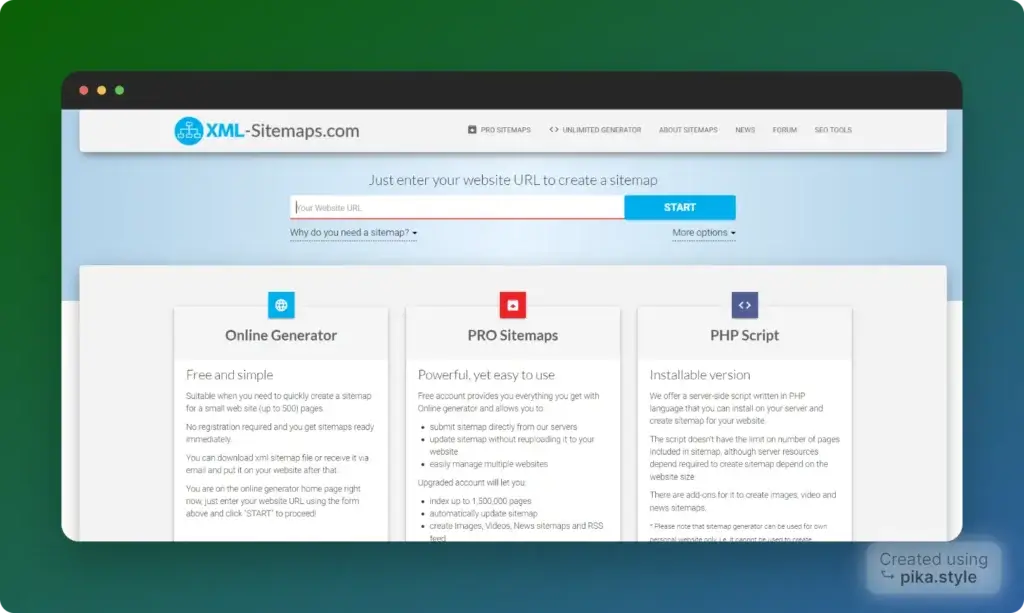
- Comprehensive Sitemap Generation: XML-Sitemaps.com offers a comprehensive tool for generating sitemaps that assist search engines in efficiently navigating and indexing websites.
- Multiple Sitemap Types: It has various sitemap types, including Standard Sitemap, Image, News, Video, Broken link and RSS feed catering to diverse content types.
- Easy Import Options: Users can initiate the sitemap creation process by importing existing website data through URLs, sitemap index files, or Google XML files, ensuring accuracy in page hierarchy representation.
- No Registration Required: No need for registration or signup, you can start creating sitemaps immediately.
- User-Friendly Interface: The platform is designed with a user-friendly interface, allowing for easy navigation and customization in sitemap creation.
- Download and Delivery Options: Sitemap files can be downloaded or sent via email for easy access and distribution.
- Plain Text Version: Offers a plain text version of the XML sitemap, convenient for copying and pasting into your website’s .htaccess file.
- Free Version: The tool is free for up to 500 URLs & for unlimited capabilities, there is an option available at a price of $49.99.
- Web-Based Tool: XML-Sitemaps.com operates as a web-based tool, eliminating the need for software installation and enabling easy access from any browser.
4. Sitemap Writer Pro
Sitemap Writer Pro is an easy-to-use program, fast and efficient. Some of its features are:
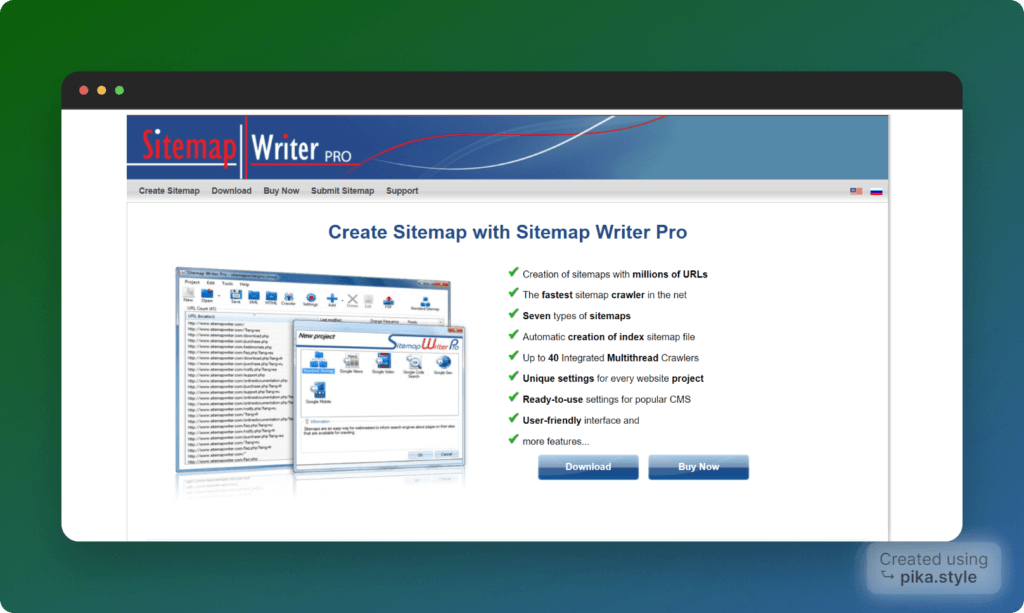
- User-Friendly Interface: Sitemap Writer Pro boasts an easy-to-use interface, ensuring a smooth experience for users in creating and managing sitemaps.
- Versatile Sitemap Types: The tool supports various sitemap types, including Standard Sitemap, Google Image, Google News, Google Video and Google Code Search, catering to diverse content and search engine requirements.
- Integration with Major Search Engines: Easily integrates with major search engines such as Google and Bing, Yahoo, Ask.com and Moreover.com providing comprehensive insights into website performance.
- Affordable Pricing: Sitemap Writer Pro is priced at $24.95, offering an affordable solution.
- Software Application: Sitemap Writer Pro is a standalone software application, eliminating the need for constant internet connectivity and offering flexibility in usage.
- Detailed Information: Provides accurate and detailed information about your website’s pages, articles, and products for search engines.
5. Slickplan
Slickplan lets you create and manage sitemaps that are easy to edit and update whenever you need. Some of its features are:

- Sitemap Creation: Slickplan offers a user-friendly platform for creating and managing sitemaps.
- Versatile Import Options: Users can initiate the sitemap creation process by importing existing website data through URLs, sitemap index files, or Google XML files, ensuring accuracy in page hierarchy representation.
- Drag-and-Drop Interface: The tool supports building sitemaps from scratch using a drag-and-drop interface, enabling easy customization and quick adjustments.
- Pricing: It offers various plans like 14-Day Free Trial, Basic Plan of $10.79, Pro $31.49, Team plan of $ 62.99 and Agency plan of $ 103.49.
- Web-Based Tool: Slickplan operates as a web-based tool, eliminating the need for software installation and enabling easy access from any browser.
- Easy Editing and Updating: Slickplan facilitates the creation and management of easily editable and updatable sitemaps, ensuring flexibility whenever modifications are needed. It also allows for numerous edits at once.
- Feature-Rich Sitemap Generation: Offers several features to help generate optimal sitemaps, ensuring comprehensive representation of your website’s structure.
6. Screaming Frog
Screaming Frog is a powerful sitemap generator for websites, large or small. Some of its features are:
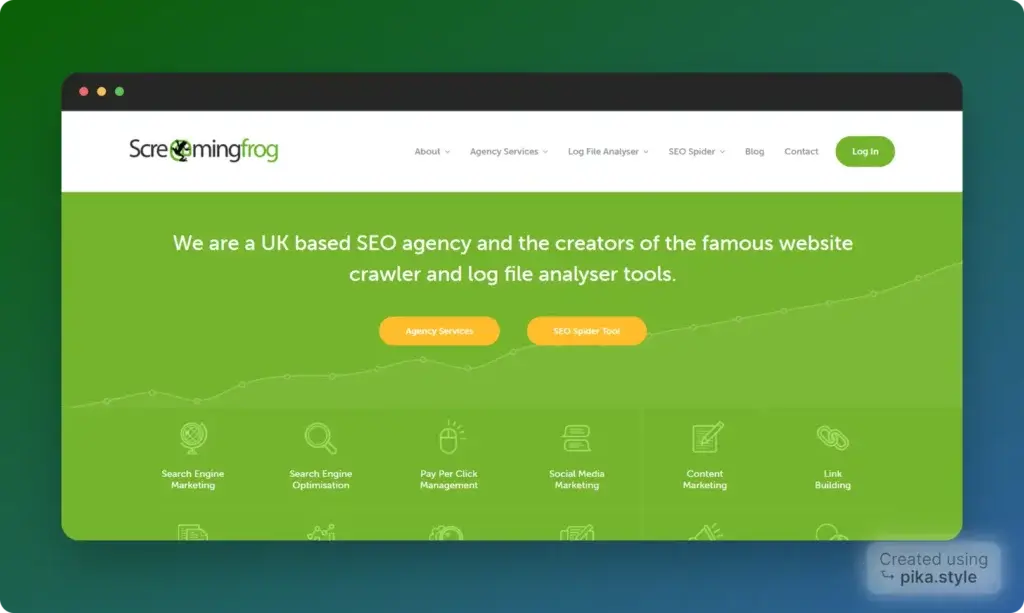
- Powerful Sitemap Generator: Screaming Frog is a robust sitemap generator suitable for websites of varying sizes, from small to large.
- Integration with Major Search Engines: Seamlessly integrates with Google, Bing, and other major search engines, providing comprehensive insights into your website’s performance.
- Web Crawling Capability: Functions as a website crawler, allowing you to scrape web pages and generate XML sitemaps.
- Crawl Progression Steps: It has some basic steps like: Crawling the Website, Click Sitemaps, Generate XML Sitemap, Select Pages to Include.
- Validation and Analysis Features: Validates URL status codes, find duplicate content and broken links, assists in identify best keywords for optimization
- Report Generation: Enables the generation of detailed reports based on the crawled data, aiding in website analysis.
- Pricing: The tool is free for up to 500 URLs, and also has unlimited plan of $259 annually, offering expanded capabilities and resources.
- Software Application: Screaming Frog operates as a standalone software application, eliminating the need for constant internet connectivity and offering flexibility in usage.
Wrapping Up
As per SEO consultant company, sitemaps are essential for your website navigation and SEO efforts. A sitemap helps Google understand the structure of your site and can help in the crawl efficiency, reduction of crawl errors, and increase page load speeds. So, it is highly recommended to have a proper sitemap to guide users and search engine crawlers.
Also read: How to Optimize Page Load Time












